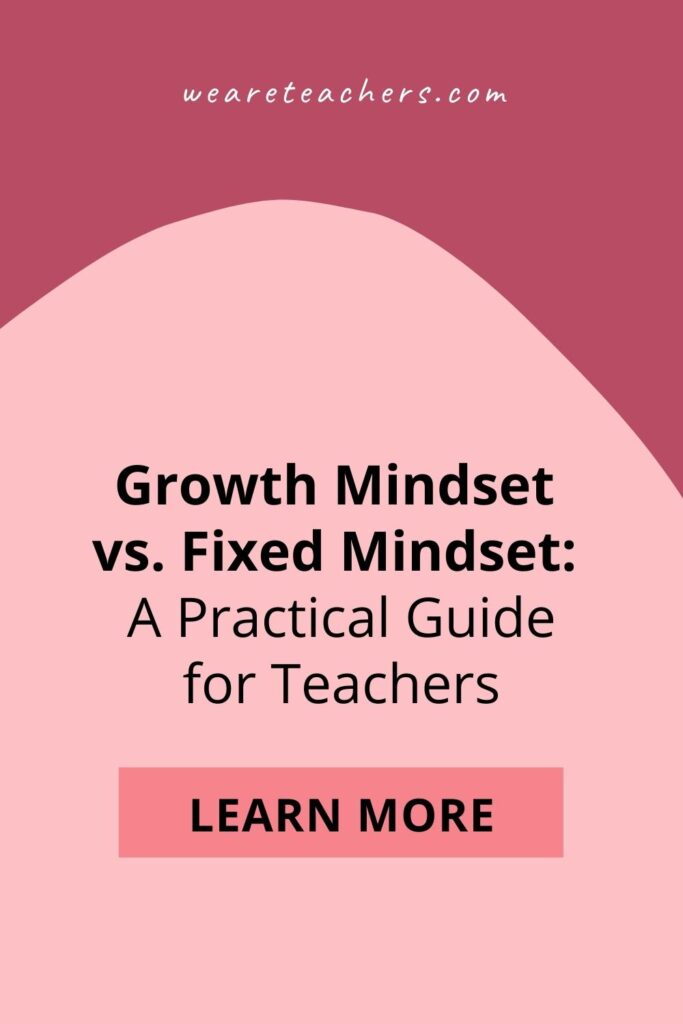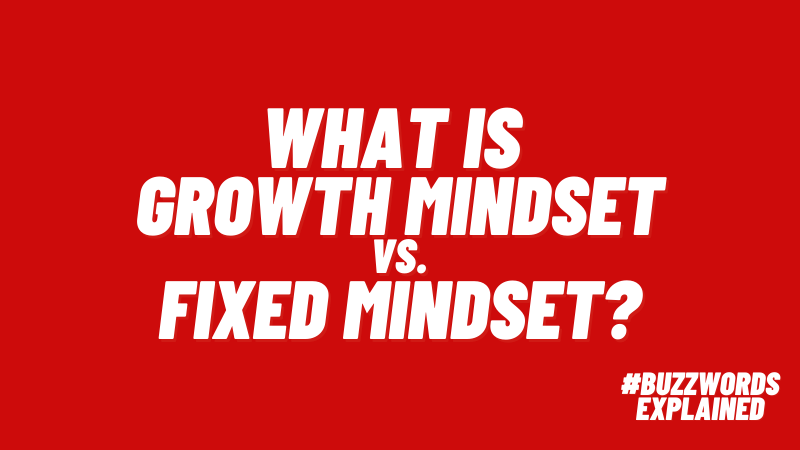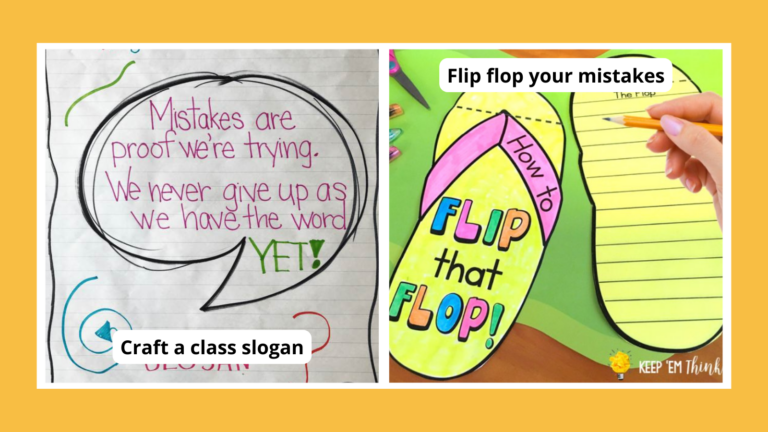Many schools today talk about teaching kids growth mindset vs. fixed mindset. They say a growth mindset can help students to embrace challenges, learn how to fail and try again, and be proud of even small improvements. But what is a growth mindset exactly, and how can teachers really make it work in their classrooms?
What is growth mindset vs. fixed mindset?
Psychologist Carol Dweck made the idea of fixed vs. growth mindsets famous with her book Mindset: The New Psychology of Success. Through extensive research, she found that there are two common mindsets, or ways of thinking:
- Fixed mindset: People with a fixed mindset feel that their abilities are what they are and cannot be changed. For instance, a person may believe that they’re bad at reading, so they don’t bother to try. Conversely, a person may feel that because they’re smart, they don’t need to work very hard. In either case, when a person fails at something, they simply give up.
- Growth mindset: Those with this mindset believe that they can always learn new things if they make enough effort. They embrace their mistakes, learning from them and trying new ideas instead. They’re not afraid to fail and try again.
Dweck found that successful people are those who embrace a growth mindset. Though we all alternate between the two at times, focusing on a growth-oriented way of thought and behavior helps people adapt and change when needed. Instead of thinking “I can’t do this,” these people say, “I can’t do this YET.”
Growth mindset is key for learners. They must be open to new ideas and processes and believe they can learn anything with enough effort. It sounds simplistic, but when students really embrace the concept, it can be a real game-changer.
What do these mindsets look like in the classroom?
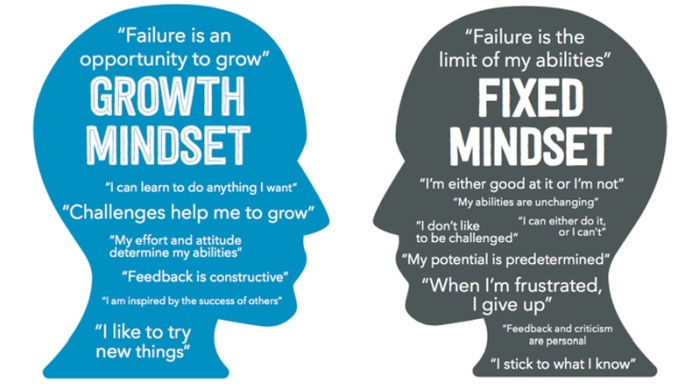
Source: Intelligent Training Solutions
Recognizing a fixed mindset is the first step in helping students grow. Nearly all kids (all people, in fact) tend to want to give up when things get too difficult. That’s completely understandable. But when students become firmly entrenched in a fixed mindset, they often give up before they even try. That stops learning and growth dead in its tracks.
Fixed Mindset Examples
Fifth grader Lucas has never been good at math. He finds it boring, and often confusing. Throughout his elementary years, he’s done just enough to get by, but now his teachers are realizing he barely knows his basic math facts and is nowhere near ready for middle school math classes. They provide him with one-on-one tutoring from a classroom aide, but Lucas isn’t interested in trying. When the aide gives him an activity, he just sits and stares at it. “I can’t do it,” he tells her. “You haven’t even tried!” she replies. “Doesn’t matter. I can’t do it. I’m not smart enough,” Lucas says, and refuses to even pick up the pencil.
High school sophomore Alicia gets easily overwhelmed when she has to tackle big projects. She doesn’t know how to get started, and when her teachers or parents offer help, she refuses. “It’s just too much,” she tells them. “I can’t do stuff like this—I always fail.” In the end, she often doesn’t even bother to try and has nothing to turn in at all.
Jamal is in eighth grade and is choosing his high school classes. His teachers have noticed he has a lot of potential but tends to stick to what’s easy. They recommend he take some challenging honors classes as he starts his high school journey, but Jamal’s not interested. “No thanks,” he tells them. “I’ll feel better if I just take stuff that’s not very hard. Then I know I won’t fail.”
Growth Mindset Examples
Olivia is in fourth grade. She’s always found school pretty easy, but this year she’s struggling with fractions. In fact, she failed a test for the first time in her life. Concerned, she asks her teacher for help. “I just can’t seem to understand this,” she says. “Can you explain it another way?” Olivia recognizes that failure just means she needs to approach something differently and try again.
Ms. Garcia is organizing the seventh grade play and asks quiet student Kai if he’d be interested in participating. “Oh, I’ve never done anything like that before,” he says. “I don’t know if I’d be any good at it. Lots of kids are probably better than I am.” She encourages him to at least try out, and he decides to give it a shot. To his surprise, Kai earns a leading role, and though it’s a lot of hard work, his opening night is a real success. “I’m so glad I decided to try this even though I was scared!” Kai tells Ms. Garcia.
High school junior Blake is about to start applying to colleges. During a conversation with their guidance counselor, Blake presents a list of five places they’d like to apply to, including several Ivy League schools. “Those places are pretty challenging to get into,” warns the guidance counselor. “I know,” Blake responds. “But I won’t know unless I try. The worst they can say is no!” Ultimately, Blake is accepted at several good schools, but not the Ivy League ones. “That’s OK,” they tell their guidance counselor. “I’m glad I at least tried.”
Does encouraging a growth mindset vs. fixed mindset really work?
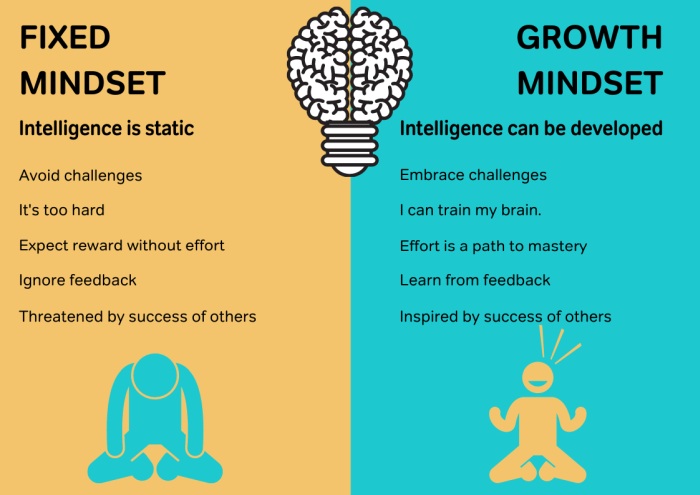
Source: Alterledger
“Well, that all sounds great,” you might be thinking, “but does it really help, or is it just a bunch of feel-good stuff?” It’s true that embracing a growth mindset isn’t as simple as just tacking on the word “yet” to every negative sentence. But when students really internalize it, studies indicate that growth mindset really does make a difference.
The key seems to be starting earlier. It’s much easier to help a young child develop a growth mindset than to get an older student to change their fixed mindset. Interestingly, one study indicated that middle school students were the least likely to change their mindsets, while elementary and high school students were more flexible.
It’s also important to remember that just telling kids about the difference between the two mindsets isn’t enough. You’ll need to do more than hang encouraging posters on the wall and tell students they can do anything if they just try hard enough. Overcoming a fixed mindset takes effort, time, and consistency.
What does a growth mindset classroom or school look like?
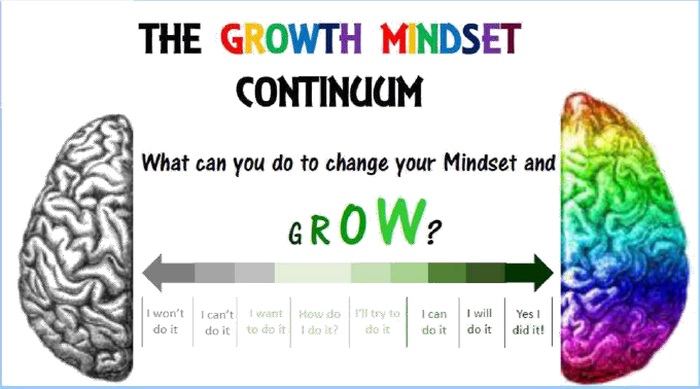
Source: Nexus Education
Want to start building a growth mindset with your students? Here’s what that might look like.
Praise effort and positive attitude, rather than ability.
Growth mindset recognizes that not everyone is good at everything right off the bat, and ability is only part of the battle. When you praise a student for being “smart” or “a fast reader,” you’re only recognizing an ability they were born with. Instead, try to recognize their efforts, which encourages them to try even when it’s not easy.
- Instead of “Congratulations on acing that test. You’re so smart!” say, “Congratulations on acing that test. You must have worked really hard!”
Teach kids to accept failure as part of learning.
So many students think if they don’t get it right the first time, they’re automatically failures. Show them videos of Olympic gymnasts practicing new moves over and over again. Point out that in the beginning, they fall more often than they succeed. Over time, though, they eventually master the skill. And even then, sometimes they fall—and that’s OK.
- When a student fails, ask them to think about what went wrong, and how they’ll do it differently next time. This should become an ingrained habit, so failure is just part of the process of learning.
Don’t punish students for trying and failing, as long as they’re willing to try again.
How do you react when students get something wrong or fail a test? To nourish a growth mindset, try giving them another chance to get it right whenever possible. For example, if you call on a student to answer a question and they get it wrong, don’t move immediately to another student. Instead, thank them for trying, and ask them to rethink their answer and try again. Kids should feel like it’s OK to make mistakes.
- Consider allowing a “re-do” when a student clearly tried the first time but still didn’t quite get there. This might mean allowing a test retake or essay rewrite after the student spends more time with the material, or learns to approach it a different way.
Value improvement as much as achievement.
The only way to overcome an “I can’t do it” attitude is to give them low-stakes ways to learn they can. Rather than only pointing out new mistakes, take time to notice previous mistakes kids are no longer making. Show them how far they’ve come, even though it’s taken them baby steps to get there.
- Praise high-scorers on tests or projects, but also be sure to recognize those who’ve made improvements over their previous efforts, even if they’re not among the top of the class. Be specific about the improvements you see, and make “Most Improved” something to be proud of.
Let students know their efforts matter.
If you’re going to build a growth mindset, you’ve got to do away with an “all-or-nothing” approach to grading. When you can, give partial credit when students have obviously made a valiant effort. (That’s why we ask them to show their work!) Thank kids for being willing to try something new, even if they didn’t get it right.
- Instead of chastising a student who fails, ask them if they think they truly gave it their all. If they did, then they clearly need some more help with that particular task. If they didn’t give it their best, ask them why not, and what they could do differently next time.
Check out 20 Growth Mindset Activities To Inspire Confidence in Kids.
How can teachers help flip a fixed mindset to a growth mindset?
(Want a free copy of this poster? Click here!)
A student entrenched in a fixed mindset can be incredibly frustrating. Let’s take another look at the examples from above, and consider how a teacher might help each student change their mindset.
“I can’t do math!”
Fifth grader Lucas has simply decided he can’t do math, and refuses to even try. During a study session, the classroom aide asks him to name something he’s always wanted to learn how to do. Lucas says he wishes he could learn to do a basketball layup.
For their next study session, the classroom aide takes Lucas to the gym and has the PE teacher spend 20 minutes helping him practice layups. She films him at the beginning and end, and shows him his improvement.
Back at their desks, the aide points out that Lucas is clearly capable of making improvement and learning new things. Why doesn’t he think that applies to math? Lucas is truculent at first, but then admits he’s just tired of getting stuff wrong all the time. He agrees to try some new activities the aide has arranged. It won’t be fun, but he’ll at least try, and that’s a start.
“I always fail.”
Sophomore Alicia shuts down when faced with a big project. Her teacher has offered to help her organize her thoughts and set up a schedule to stay on task. Alicia says that kind of stuff doesn’t help her—she still never gets it all done on time.
Her teacher asks her what methods she’s tried when approaching big projects. Alicia explains she used a project planner for a science fair project once, but she lost it. She fell further and further behind, and in the end decided her project wasn’t even worth turning in.
Alicia’s teacher offers to help her break her project into smaller parts, and suggests that he grade each part separately as she finishes it. That way, it’s worth it for Alicia to make at least some effort. Alicia agrees, and though she still doesn’t finish the whole project, she achieves enough to get a passing grade. Plus, she’s developed time management skills to use the next time around.
“I’ll just stick to what I know I can do.”
Middle schooler Jamal is hesitant to try challenging new classes in high school. He’s always gotten good grades in his classes, and he doesn’t want to risk failure. Jamal’s guidance counselor asks him if any of the challenging classes look interesting, and he says he loves science. She suggests he at least take AP Biology. “But what if it’s just too much for me to keep up with?” Jamal worries. “Or what if I put in all that work, and I don’t do very well on the AP test?”
The counselor points out that even if he doesn’t score well on the AP test, he’ll still have had the unique experiences available only in that class. And if he really does struggle, he can get help, or even change to the regular biology course. In the end, Jamal agrees to enroll in the class, even though he’s a little uncomfortable. He decides to take on a new challenge and see what he can accomplish.
More Growth Mindset Resources
Growth mindset doesn’t work for every student, it’s true. But the potential benefits make it worth keeping in your teacher toolkit. Use these resources to learn more about growth mindset vs. fixed mindset.
- Mindset Works: Why Mindsets Matter
- 8 Steps to Develop a Growth Mindset
- Mindset Health: Growth Mindset vs Fixed Mindset
- Establishing a Growth Mindset as a Teacher
How do you encourage a growth mindset vs. fixed mindset in your students? Come share your ideas and ask for advice in the WeAreTeachers HELPLINE group on Facebook.
Plus, check out 18 Perfect Read-Alouds for Teaching Growth Mindset.
